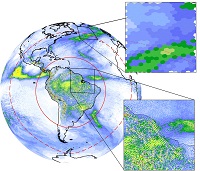Atmospher Sci & Global Chg
Research Highlights
September 2015
A Zoom Lens for A Global Climate Model
PNNL scientists look more deeply at smaller areas to improve climate modeling globally

A study led by PNNL researchers showed that when climate models zoom in on a particular part of the globe, the resulting analysis can improve understanding of both regional and global climate. The global simulation (inset top) can average out effects in large areas, while the high resolution simulation (inset bottom) captures much more of the regional interactions. Graphic courtesy of the author.
Results: Like a camera, computational models focus on the big picture when simulating global climate. They capture atmospheric patterns and simulate the transfer of heat and water. But a big picture focus means sometimes missing fine-scale processes such as regional interactions between the atmosphere and the underlying land surface.
In the last ten years, scientists have developed "multi-resolution" models that can zoom in on a region while still looking at global patterns. The question has been: how well do those models perform with such differences in resolution? Now, as reported in the Journal of Climate, a research team led by Pacific Northwest National Laboratory showed that these multi-resolution models are as skillful as detailed global models in predicting regional climate but require only a fraction of the computational resources.
Why It Matters: Calculating all the fine details of regional climates across the globe can be challenging, even with the most sophisticated computers. Yet lesser simulations that only look at specific regions in detail cannot tell us how the climate will change around the world under certain conditions. Neither case allows planners to project extreme weather events or long-term trends that can affect everything from crops to building codes.
The PNNL team's efforts showed that new-generation multi-resolution models such as the Model for Prediction Across Scales-Atmosphere (MPAS-Atmosphere), which was used in this study, provide two-way interactions between local- and global-level processes. The promising approach improves climate simulations without requiring extensive computational resources.
"The MPAS-Atmosphere multi-resolution model is a powerful tool for simulating regional climate," said Dr. Koichi Sakaguchi, lead author of the article. "Our findings also demonstrate the importance of capturing interactions between the atmosphere and the underlying land surface such as mountains, valleys, and seas."
Methods: PNNL researchers teamed with collaborators from Los Alamos National Laboratory, University of Delaware, Auburn University, and the National Center for Atmospheric Research to analyze four simulations that covered a ten-year period. The first simulation had a coarse resolution around the globe (a grid with 120-kilometer cells covering the Earth); the second had fine resolution around the globe (30-kilometer grid cells). The final two simulations had a coarse resolution over most of the globe, with a finer-resolution focus over a particular area (North America in one case and South America in the other).
The scientists carefully evaluated many aspects of the climate in the four simulations, using measurements taken from the area, data pulled together from other studies, and data produced by the model. They looked at precipitation and atmospheric circulation among other factors before determining that the model was accurately portraying regional climate and informing global climate calculations.
What's Next? The study began to answer some questions about the use of multi-resolution models for climate prediction, but it also raised others. Researchers found that zooming in on certain regions led to surprising changes in how the model responded on the global level. Scientists are hoping to better understand these so-called "up-scaling" effects and analyze how the "zoomed-in" resolution influences the regional atmospheric and moisture dynamics. They are applying the approach to other regions to test its consistency.
Acknowledgments
Sponsor: The U.S. Department of Energy's (DOE's) Office of Science, Biological and Environmental Research supported this project as part of the Regional and Global Climate Modeling Program.
Research Team: Koichi Sakaguchi, L. Ruby Leung, Chun Zhao, Qing Yang, Jian Lu, and Samson Hagos, PNNL; Sara Rauscher, University of Delaware; Li Dong, Auburn University; Todd Ringler, Los Alamos National Laboratory; Peter Lauritzen, National Center for Atmospheric Research
Research Area: Climate & Earth Systems Science
Facilities: The team used computational resources from the National Energy Research Scientific Computing Center, a DOE user facility supported by the Office of Science. PNNL's Institutional Computing program provided additional computational resources.
Reference: Sakaguchi K, LR Leung, C Zhao, Q Yang, J Lu, S Hagos, SA Rauscher, L Dong, TD Ringler, and PH Lauritzen. 2015. "Exploring a Multi-Resolution Approach using AMIP Simulations." Journal of Climate 28(14): 5549-5574. DOI: 10.1175/JCLI-D-14-00729.1
